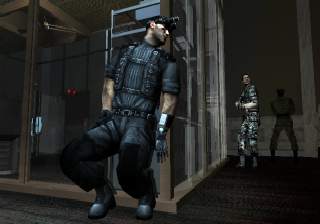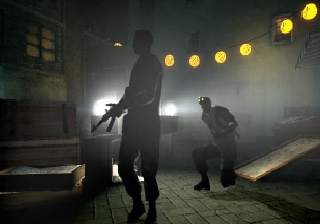March 16, 2007 4:16PM
Splinter Cell: Chaos Theory

Splinter Cell: Chaos Theory is the third game in the Splinter Cell series, released in 2005 to positive reviews, making it the 6th highest rated Xbox game, and the 32nd highest rated game of all time (and the highest rated game in the Splinter Cell series). The game was developed by Ubisoft Montreal, the same development studio that created the first game (but not Pandora Tomorrow, which was developed by Ubisoft Shanghai), so the game was made by those who were responsible for Splinter Cell in the first place, and you can tell.
Technically speaking, Chaos Theory is a marvelous game. The game features quite possibly the most attractive graphics and visual style available on any last-gen console. The bump mapping and amazing lighting just never gets old, and level after level the visual style will just leave you amazed that you aren't playing this on a 360. The graphics are leaps and bounds ahead of the first Splinter Cell and quite a step up from Pandora Tomorrow. The only downside of having such glorious visuals is that when the game is turned on, it has to copy a bunch (see: a shitload) of files to the Xbox hard drive (textures, secret government files, other data) so that the game can look that good without giant loading screens and slowdown. While the files are copying it plays a movie showing off Chaos Theory, but after you've seen it once, you don't really want to see it again, but it's worth the wait in order to play such a nice looking game. The temporarily files will stay on the hard drive as long as you don't play too many other games (which copy their own files and remove Chaos Theory's) so, so long as the temp files are still there the next time you turn on Chaos Theory, you can just skip the movie and get into the game right away (which is very nice).
Chaos Theory is basically all the fun things from the original, all the non-fun things taken out, and a few new things that you didn't really think about as part of the game but are awesome. So.. let's see here... fun things from the original game include: Stealth gameplay where you can hide in shadows and become invisible so long as your light meter is in the bottom section, the ability to walk slowly and sneak up behind enemies and grab them, lock-picking, shooting out lights to create shadows, fun spy/conspiracy-type storyline and others. The biggest change comes from the developers taking out some of the things that made the original frustrating and unfun in areas but still making the game work. For example, in the first two games, when you reached a checkpoint in the level, the game would scan the previous section you just went through, and if a body was anywhere visible (ie. not in a pitch black shadow) an alarm would trip which would result in either mission failure or close to mission failure. In Chaos Theory, you don't have to hide bodies, because there is no 'scan the previous section for bodies' feature, in fact, the only way bodies can do you harm is if a patrolling guard actually comes across one, either by seeing it (meaning the body wasn't in a shadow) or by actually running into it. What this means is that in the original game you had to knock out enemies and then take time to pick them up, move them to an out of the way dark place and do that for every enemy, then when you reached a checkpoint, if you didn't put down a body completely in shadow, like maybe it's just a tiny bit in the light, it could totally fuck up your mission, even if there are no guard or cameras around the find the bodies, so it's unrealistic and frustrating, whereas in Chaos Theory, as long as you don't throw a body down in front of a camera, and you don't put a body down in the path of a patrolling guard, you don't really have to worry about where they are.
Another change is the alarm system. In the first two games, most missions had a three alarm limit. First alarm goes off, the enemies put on body armor making them more difficult to kill. Second alarm goes off, enemies put on helmets making it impossible to get headshots. Third alarm goes off, you lose the mission and game over. In Chaos Theory, there are no alarm limits, basically, every time the alarm goes off, the enemies will grab better equipment, become more alert so it's difficult to hide from them, they'll grab flashlights and flares, so it's more realistic rather than... game-ish.


Some things they added to the formula include... level scores! When you finish a level, they give you a percentage based on how well you did. Things that can lower your percentage are: killing enemies, setting off alarms, missing objectives, and being identified as an intruder, and others. To get 100% on a level, you basically have to complete every objective (even the optional ones), sneak through the level not being seen and not touching a single enemy and get out the same way. It's difficult, but injects replayability into a game that you never really expected to have a score based replay system. Also added were optional objectives that you don't have to do but doing them increase your level score and modify the story slightly, branched paths which means different ways to get through a level, giving the player freedom to make their own plan and methods, making it more open ended and not an 'on rails' type thing (which is game-ish). Basically they just took out the things that were unrealistic and used to set rules and boundaries for the game, and added in things to make it more realistic and open, so the player is given the tools and placed with objectives and it's up to them to play the game however they want.
One of the biggest changes is the removal of checkpoints and save points from the first two games. Instead, the player is free to save (and quick save) at any time, as much as they want. Yes, this makes the game pretty easy, but it takes out the frustration of having to do the same 15 minute section of a level over and over again. Quick saving after clearing a room successfully is actually quite satisfying.
Some things that they did that weren't really new but really made the game more fun were things like... when you grab an enemy you can choose to knock them out or kill them (instead of just knocking them out). Most enemies can be interrogated now, telling you various small hints about the room your in, or different paths you can take, keycodes, ammo and medkits and stuff. In the first couple games there were only like two people you ever had to interrogate, so it was kind of gimmicky, but in Chaos Theory, you generally want to try to sneak up and grab guards instead of shooting them so you can get some info out of them and learn something useful. There are just countless things they did to make Chaos Theory so much fun and so much better than the other Splinter Cells, it's hard to list and explain them all.
I knew going in that Chaos Theory was viewed as the greatest Splinter Cell game, so my expectations were high, and I wasn't let down. Right away I could tell that the improvements implemented really did improve and there were no new negative aspects, and most of the negatives of previous games had been eliminated completely. I wasn't disappointed with this game, in fact it was even better than I had thought it would be, and it was so good, that I plan on playing through it again and try to get more than 80% on each level. I have to give this game a 10, and I have to recommend this game to anyone who likes games in general, because it's so fucking awesome, everyone has to play it.

yes, you can fuckin hang down and break necks
1373 words
Timeline
- I lived on Grey St.
- Michelle was my Roommate
Leave a Comment
Your email address will not be published. Required fields are marked *